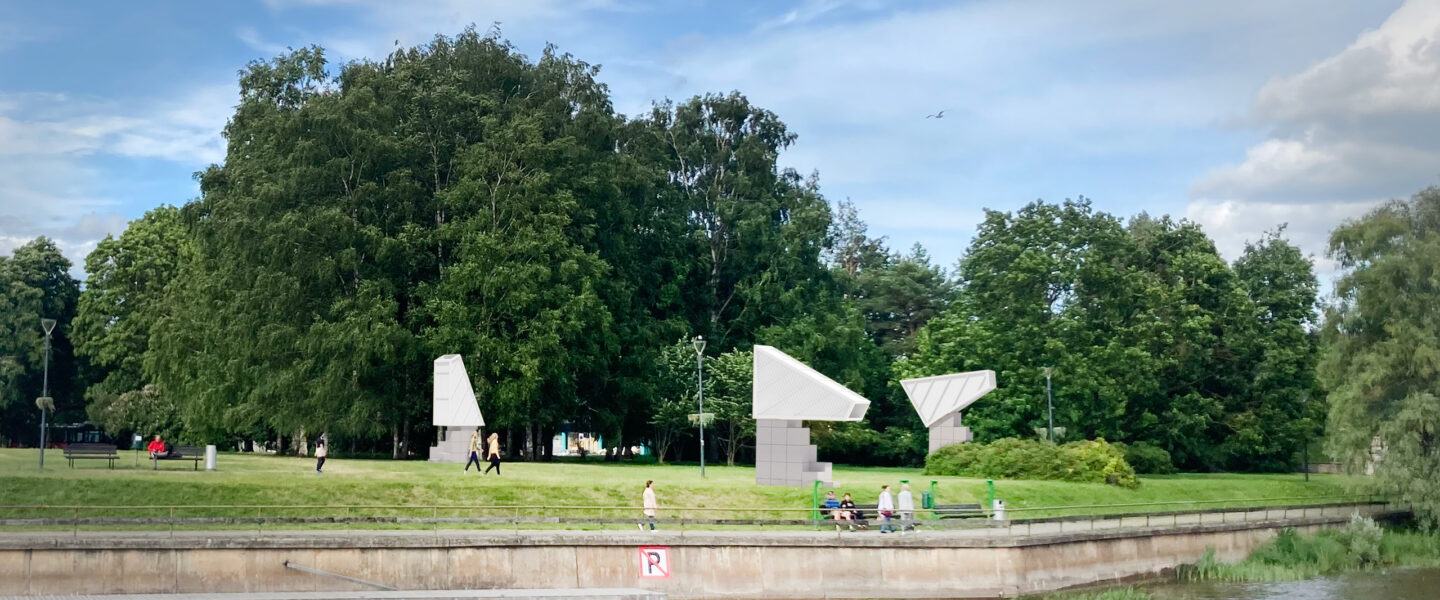
This Friday, July 29, at 5 pm, the students of the Estonian Academy of Arts Faculty of Architecture will open the wooden shelter/installation KINO on the bank of River Emajõgi in Tartu, which, according to the architects Alvin Järving and Ott Alver who supervised the students, resembles a machine rather than a building – it is an object that pushes boundaries in a good way, the unexpected form of which is 100% of the content.
Observe the construction process: https://www.instagram.com/eka_varjualune
The shelter/installation KINO is an educational project created by students of the 1st year of architecture and urban planning at EKA and completed during the mandatory summer construction internship, as a team. Designing and building a shelter has been the first major study task of EKA architecture students for many years. Last winter, among several ideas developed for Tartu centre, at the invitation of the city, one project was selected – KINO, proposed by student Alis Mäesalu, and this has now been built together with the whole team of students from 1st year.
The three-part KINO will remain for the people to use until the end of Tartu’s cultural capital year, 2024. The shelters for the next few years will also be planned specially for Tartu.
According to the supervisors of the shelter project, architects Ott Alver and Alvin Järving, the three-part KINO stood out because it resembles a machine rather than a building: “It operates like a camera, a screen and a cinema hall at the same time. You could even say that KINO’s three parts automate Estonian Film – in each shelter, a well-composed shot of an Estonian film is “screened”, which helps the visitor to feel bored, and search for sense of their existence.”
The author of this year’s shelter, architecture student Alis Mäesalu says that Tartu is an exciting city, unafraid to experiment with different ideas to make the urban space better, more interesting and more sustainable. When she started planning the shelter, Alis set herself the goal of offering the Tartu people a place to search for mental peace in the urban environment: thus a three-part KINO is stands, where you can hide, and which frames a small piece of the surrounding city, for the person who enters it. “A person can choose between three different shelters to find a suitable place for themselves, where to sit or lie on their back and watch the slow change of the surroundings and the dancing of moths around the lit street lamp from the opening of the wide screen of KINO. In this way, you can wade through the intrusive boredom and, perhaps, reach a silence of thoughts. Or, at least, rest your feet for a while and take some time off. Take a break, from everything,” says Mäesalu.
“Last year, we laid the foundation for a new tradition – until 2024, the destination of the shelter project will be the center of Tartu. We promote and show the possibilities of using wood by setting up installations and we support for students as an organisation. The end result of the work offers the Tartuvians and our guests the opportunity to observe the city from a completely different angle,” said Anna-Liisa Unt, landscape architect of Tartu Spatial Creation Department.
“Wood as a building material is still underutilised in the world, but it is becoming more and more popular. The development of technology has led to the fact that skyscrapers of up to 20 stories can be built from wood – in other words, in essence, 99% of all the housing stock we need could come from sustainably and economically cultivated forests. If you take into account that our environment also has a price, it is also more affordable than concrete construction,” said Henrik Välja, head of the Estonian Forestry and Wood Industry Association, which supports the construction of the shelter. “That is why the EKA shelter project is forward-looking, and hopefully architects who love and value wood as an innovative and at the same time environmentally friendly material will grow out of it”.
Planning the shelter and building it together with the entire year has been the major project of the first academic year of EKA architecture students for 17 years. This year’s shelter is the 2nd to be built in Tartu, after NURK in 2021. KINO was completed with the support of the City of Tartu, the Estonian Cultural Foundation, the Estonian Forestry and Wood Industry Union, the Environmental Investment Center, Raitwood, Palmako and EKA.
EKA architecture and urban planning 1st course design work group: Alis Mäesalu, Tuule Kangur, Darja Gužovskaja, Madis Arp Keerd.
Construction: Aiko Liisa Olek, Anabel Ainso, Anu Alver, Anneli Virts, Arabella Aabrams, Frank Kuresaar, Fred-Eric Pavel, Hugo Georg Kalaus, Karl Robin Timm, Karmo Viherpuu, Kristian Tigane, Laura Haki, Laura Venelaine, Liisalota Kroon, Rasmus Roosileht, Triinu Lamp.
The course project was supervised by Ott Alver and Alvin Järving from the architect office Arhitekt Must, Ragnar Kekkonen directed the students in the carpentry workshop, and Andres Lehtla directed the constructions.
You can read more about the idea of the shelter series and all the objects built so far here: https://www.artun.ee/erialad/arhitektuur-ja-linnaplaneerimine/tood/varjualused
Questions:
Alvin Järving
+372 555 82010
